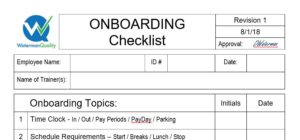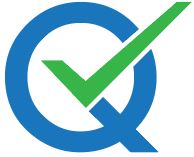Employee Training – Onboarding Checklist

Management and supervision are responsible for ensuring that their employees know what to do, are prepared to perform those duties, and perform their tasks correctly. Job or work instructions, coupled with on job training, prepare the employees with the knowledge of what they are expected to do.
- Supervision verifies that the workplace is sufficient
- Employee training and experience ensures capability
- Follow-up such as inspections and audits validate that the job has been performed correctly.
“Cultural” Expectations of the Workplace
The job function is the key responsibility of an employee, but there are a host of other expectations that also should be defined and communicated. What are the expectations for clocking in and out of the workplace? What are the allowances for telephone calls, texts, breaks, and such? Is there a dress code, and is any personal protective equipment (PPE) required? Is music allowed? When is lunch? Who are your co-workers? Where are the bathrooms for your department? …
Employee handbooks are a collection of a large amount of information for our employees. It is an efficient way to accumulate and communicate policies and general expectations, but not the best way to communicate standard expectations. A better tool is to have a standard new employee process which includes employee orientation and onboarding. A checklist that accompanies the standard onboarding process helps ensure that all employees are given the same set of instructions.
Onboarding Checklist
The onboarding checklist is a simple document which provides documented evidence that all employees have been given the same information regarding their new place of employment. It also provides the Supervisor or Lead with a document to reference as they provide the information to the new employee. And it provides the employee with a summary of the information to which they have been presented.
The items listed on the checklist need to be well defined and communicated to the person who delivers that item to ensure the consistency of the training for each employee.
A simple Word document or Excel spreadsheet can be used for this purpose, to include such items as:
- Employee Name and Number
- Date of Hire / Training
- Department / Trainer
- Onboarding Contents:
- Department Orientation
- Department Introductions
- Documentation Locations
- Quality Policy
- 5S Requirements
- Required PPE
- Emergency Exits
- Fire / Tornado Protocol
- Bathrooms
- Break Locations
- (etc)
- Trainer Signature and Date
- Employee Signature and Date
The above checklist, upon completion, can be copied to the employee’s file in the department and / or HR to provide documented evidence of this important training. In some organizations, it has worked well to have onboarding checklists for each major department within the organization. Any redundant elements are reinforced to the employee who, for example, is told by both the EHS Manager and Department Supervisor about the fire drill process.
Document Creation
The first step in creating this checklist is to gather the management team affected by or to be included in the new employee instructional process to ensure full inclusion of all elements. This team should include representatives from HR, Safety, Quality, Production, Lean, and any others such as Maintenance and Engineering, to gain their buy-in and inputs. The end result is nicely comprehensive document which helps ensure that all employees know the cultural expectations for their place of employment.
Onboarding Process Validation
Yes, you will want to check up periodically to ensure that the process is being followed. Ask new employees if they know about one or more of the items noted on the checklist. Check that the completed document has been retained in the employees’ file in HR or the department.
.

